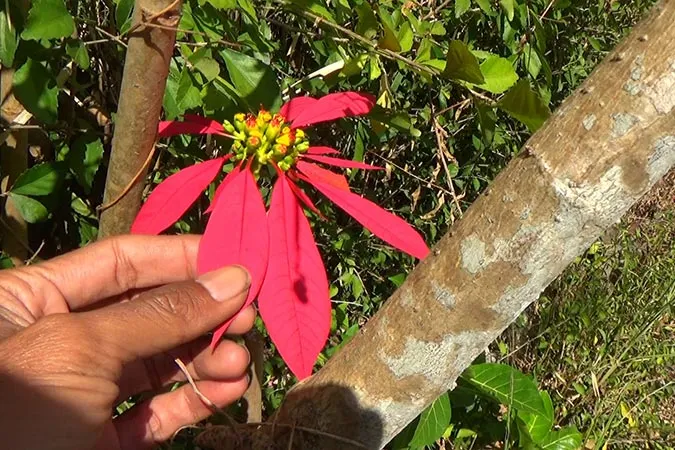Kastuba or poinsettia (Euphorbia pulcherrima) is a plant species in Euphorbiaceae which is famous for its striking leaves. Shrubs or small trees 0.6-4 meters high, forming canopy with a diameter of about 2 meters and having dark green leaves with a length of 7-16 cm.
E. pulcherrima has single elliptical or ovoid leaves with stems mostly 2-4 curves. The tip of the leaf is pointed with the arrangement of pinnate bones and the upper part is bright red or orange, pale green, cream and white according to the variety.
The color of red leaves is created through photoperiodism which requires darkness for 12 hours for at least five consecutive days to change color. At the same time, plants need abundant light during the day for the brightest colors.
Kastuba has simple flowers forming groups in small yellow structures in the middle of each leaf bunch. Single house flowers, yellow and do not fall easily for several weeks, but stamens will fall out.
Female flowers sit between male flowers without petals or crowns and are only surrounded by cyathium. Natural pollination is aided by insects, but fertilization rarely occurs, so almost never have seeds.
Fruit buds grow at the base of cyathium. Poinsettia grows optimally at a temperature of 16-27C. Forming the color of the best bractea at night with temperatures of 16-18C. These plants like the morning sun, but love shade when it starts to get hot.
Kingdom: Plantae
Clade: Angiosperms
Clade: Eudicots
Clade: Rosids
Order: Malpighiales
Family: Euphorbiaceae
Genus: Euphorbia
Species: E. pulcherrima
E. pulcherrima has single elliptical or ovoid leaves with stems mostly 2-4 curves. The tip of the leaf is pointed with the arrangement of pinnate bones and the upper part is bright red or orange, pale green, cream and white according to the variety.
The color of red leaves is created through photoperiodism which requires darkness for 12 hours for at least five consecutive days to change color. At the same time, plants need abundant light during the day for the brightest colors.
Kastuba has simple flowers forming groups in small yellow structures in the middle of each leaf bunch. Single house flowers, yellow and do not fall easily for several weeks, but stamens will fall out.
Female flowers sit between male flowers without petals or crowns and are only surrounded by cyathium. Natural pollination is aided by insects, but fertilization rarely occurs, so almost never have seeds.
Fruit buds grow at the base of cyathium. Poinsettia grows optimally at a temperature of 16-27C. Forming the color of the best bractea at night with temperatures of 16-18C. These plants like the morning sun, but love shade when it starts to get hot.
Kingdom: Plantae
Clade: Angiosperms
Clade: Eudicots
Clade: Rosids
Order: Malpighiales
Family: Euphorbiaceae
Genus: Euphorbia
Species: E. pulcherrima
